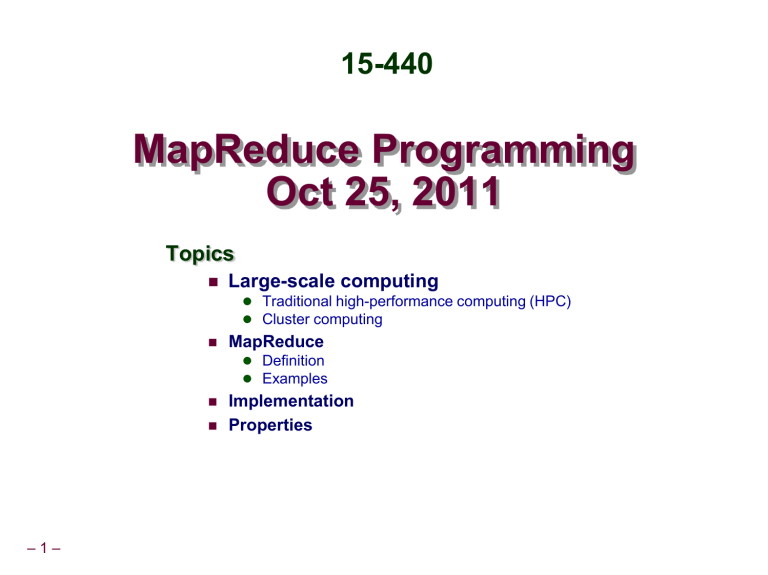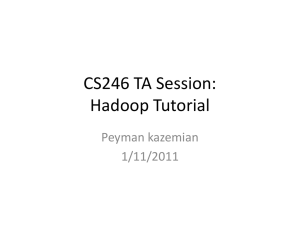MapReduce Programming Oct 25, 2011 15-440 Topics

– 1 –
15-440
MapReduce Programming
Oct 25, 2011
Topics
Large-scale computing
Traditional high-performance computing (HPC)
Cluster computing
MapReduce
Definition
Examples
Implementation
Properties
Typical HPC Machine
Compute Nodes
CPU
Mem
CPU
Mem
• • •
CPU
Mem
Network
• • •
Storage Server
Compute Nodes
High end processor(s)
Lots of RAM
Network
Specialized
Very high performance
Storage Server
RAID-based disk array
– 2 –
HPC Machine Example
– 3 –
Jaguar Supercomputer
3 rd fastest in world
Compute Nodes
18,688 nodes in largest partition
2X 2.6Ghz 6-core AMD Opteron
16GB memory
Total: 2.3 petaflop / 300 TB memory
Network
3D torus
Each node connected to 6 neighbors via 6.0 GB/s links
Storage Server
10PB RAID-based disk array
HPC Programming Model
– 4 –
Application
Programs
Software
Packages
Machine-Dependent
Programming Model
Hardware
Programs described at very low level
Specify detailed control of processing & communications
Rely on small number of software packages
Written by specialists
Limits classes of problems & solution methods
Bulk Synchronous Programming
Solving Problem Over Grid
E.g., finite-element computation
Partition into Regions
p regions for p processors
Map Region per Processor
Local computation sequential
Periodically communicate boundary values with neighbors
– 5 –
P
1
Message Passing
P
2
P
3
P
4
P
5
– 6 –
Typical HPC Operation
Characteristics
Long-lived processes
Make use of spatial locality
Hold all program data in memory (no disk access)
High bandwidth communication
Strengths
High utilization of resources
Effective for many scientific applications
Weaknesses
Requires careful tuning of application to resources
Intolerant of any variability
HPC Fault Tolerance
P
1
P
2
P
3
P
4
P
5
Checkpoint
Restore
Checkpoint
Checkpoint
Wasted
Computation
Periodically store state of all processes
Significant I/O traffic
Restore
When failure occurs
Reset state to that of last checkpoint
All intervening computation wasted
Performance Scaling
Very sensitive to number of failing components
– 7 –
Google Data Centers
Dalles, Oregon
Hydroelectric power @ 2¢ /
KW Hr
50 Megawatts
Enough to power 60,000 homes
– 8 –
Engineered for maximum modularity & power efficiency
Container: 1160 servers,
250KW
Server: 2 disks, 2 processors
Typical Cluster Machine
Compute + Storage Nodes
CPU
Mem
CPU
Mem
• • •
CPU
Mem
Network
Compute + Storage
Nodes
Mediumperformance processors
Modest memory
1-2 disks
Network
Conventional
Ethernet switches
10 Gb/s within rack
100 Gb/s across racks
– 9 –
Machines with Disks
Lots of storage for cheap
Seagate Barracuda
2 TB @ $99
5¢ / GB
(vs. 40¢ in 2007)
Drawbacks
Long and highly variable delays
Not very reliable
Not included in HPC
Nodes
– 10 –
Oceans of Data, Skinny Pipes
1 Terabyte
Easy to store
Hard to move
– 11 –
Disks
Seagate Barracuda
Seagate Cheetah
Networks
Home Internet
Gigabit Ethernet
PSC Teragrid
Connection
MB / s
115
125
MB / s
< 0.625
< 125
< 3,750
Time
2.3 hours
2.2 hours
Time
> 18.5 days
> 2.2 hours
> 4.4 minutes
Ideal Cluster Programming Model
Machine-Independent
Programming Model
Application
Programs
Runtime
System
Hardware
Application programs written in terms of high-level operations on data
Runtime system controls scheduling, load balancing, …
– 12 –
Map/Reduce Programming Model
k
1 k
1
k r
Reduce
Key-Value
Pairs
M M M
M Map
– 13 – x
1 x
2 x
3
Map computation across many objects
E.g., 10 10 Internet web pages x n
Aggregate results in many different ways
System deals with issues of resource allocation & reliability
Dean & Ghemawat : “MapReduce: Simplified Data
Processing on Large Clusters”, OSDI 2004
Map/Reduce Example
1 3 6 3 1 dick
dick, 1
and
come
see
see, 1
come, 1
come, 1
come, 1
and, 1
see, 1
come, 1
come, 2
and, 1
spot
and, 1
spot, 1
Sum
Word-Count
Pairs
M M M M M Extract
Come,
Dick
Come and see.
Come, come.
Come and see.
Come and see
Spot.
Create an word index of set of documents
Map: generate
word, count
pairs for all words in document
– 14 –
Reduce: sum word counts across documents
Getting Started
Goal
Provide access to MapReduce framework
Software
Hadoop Project
Open source project providing file system and Map/Reduce
Supported and used by Yahoo
Rapidly expanding user/developer base
Prototype on single machine, map onto cluster
– 15 –
Hadoop API
Requirements
Programmer must supply Mapper & Reducer classes
Mapper
Steps through file one line at a time
Code generates sequence of <key, value>
Call output.collect(key, value)
Default types for keys & values are strings
Lots of low-level machinery to convert to & from other data types
But can use anything “writable”
Reducer
Given key + iterator that generates sequence of values
Generate one or more <key, value> pairs
Call output.collect(key, value)
– 16 –
Hadoop Word Count Mapper
public class WordCountMapper extends MapReduceBase implements Mapper { private final static Text word = new Text(); private final static IntWritable count = new IntWritable(1); public void map(WritableComparable key, Writable values,
OutputCollector output, Reporter reporter) throws IOException {
/* Get line from file */
String line = values.toString();
/* Split into tokens */
StringTokenizer itr = new StringTokenizer(line.toLowerCase(),
" \t.!?:()[],'&-;|0123456789"); while(itr.hasMoreTokens()) { word.set(itr.nextToken());
/* Emit <token,1> as key + value output.collect(word, count);
}
}
}
– 17 –
Hadoop Word Count Reducer
public class WordCountReducer extends MapReduceBase implements Reducer { public void reduce(WritableComparable key, Iterator values,
OutputCollector output, Reporter reporter) throws IOException { int cnt = 0; while(values.hasNext()) {
IntWritable ival = (IntWritable) values.next(); cnt += ival.get();
} output.collect(key, new IntWritable(cnt));
}
}
– 18 –
Map/Reduce Operation
Map/Reduce
Map
Reduce
Characteristics
Computation broken into many, short-lived tasks
Mapping, reducing
Map
Reduce
Use disk storage to hold intermediate results
Map
Reduce
Map
Reduce
Strengths
Great flexibility in placement, scheduling, and load balancing
Can access large data sets
Weaknesses
Higher overhead
Lower raw performance
– 19 –
Map/Reduce Fault Tolerance
Map/Reduce
Map
Reduce
Map
Reduce
Data Integrity
Store multiple copies of each file
Including intermediate results of each Map / Reduce
Continuous checkpointing
Map
Reduce
Map
Reduce
Recovering from Failure
Simply recompute lost result
Localized effect
Dynamic scheduler keeps all processors busy
– 20 –
Cluster Scalability Advantages
Distributed system design principles lead to scalable design
Dynamically scheduled tasks with state held in replicated files
Provisioning Advantages
Can use consumer-grade components
maximizes cost-peformance
Can have heterogenous nodes
More efficient technology refresh
Operational Advantages
Minimal staffing
No downtime
– 21 –
Exploring Parallel Computation Models
Map/Reduce
MPI
SETI@home
Threads PRAM
Low Communication
Coarse-Grained
High Communication
Fine-Grained
Map/Reduce Provides Coarse-Grained Parallelism
Computation done by independent processes
File-based communication
Observations
Relatively “natural” programming model
Research issue to explore full potential and limits
– 22 –
Example: Sparse Matrices with
Map/Reduce
A
10 20
30 40
50 60 70
X
B
-1
-2 -3
-4
=
C
-10 -80
-60 -250
-170 -460
Task: Compute product C = A·B
Assume most matrix entries are 0
Motivation
Core problem in scientific computing
Challenging for parallel execution
Demonstrate expressiveness of Map/Reduce
– 23 –
Computing Sparse Matrix Product
A
10 20
30 40
50 60 70
1
1
2
2
3
3
3
30
A
40
A
10
A
20
A
50
A
60
A
70
A
1
2
3
1
3
2
3
B
-1
-2 -3
-4
Represent matrix as list of nonzero entries
row, col, value, matrixID
– 24 –
Strategy
Phase 1: Compute all products a i,k
· b k,j
Phase 2: Sum products for each entry i,j
Each phase involves a Map/Reduce
1
2
2
3
-3
B
-4
B
-1
B
-2
B
1
1
2
2
Phase 1 Map of Matrix Multiply
Key = row
1
1
2
2
3
3
3
1
2
2
3
30
A
40
A
10
A
20
A
50
A
60
A
70
A
-3
B
-4
B
-1
B
-2
B
1
1
2
2
1
2
3
1
3
2
3 Key = col
1
3
10
A
50
A
2
3
30
A
60
A
1
2
3
20
A
40
A
70
A
Key = 1
1
1
1
2
Key = 2
2
2
2
-2
B
-3
B
3
Key = 3
3
3
-4
B
3
-1
B
1
1
2
2
– 25 –
Group values a i,k and b k,j according to key k
Phase 1 “Reduce” of Matrix Multiply
1
3
10
A
50
A
Key = 1
1
1
X 1
-1
B
1
1
3
-10
C
-50
A
2
3
30
A
60
A
2
Key = 2
2
X
2
2
-2
B
-3
B
1
2
1
2
3
20
A
40
A
70
A
3
Key = 3
3
X 3
-4
B
3
2
– 26 –
Generate all products a i,k
· b k,j
2
2
3
3
-60
C
-90
C
-120
C
-180
C
1
2
3
-80
C
-160
C
-280
C
2
2
2
1
2
1
2
1
1
Phase 2 Map of Matrix Multiply
1
3
-10
C
-50
A
2
2
3
3
-60
C
-90
C
-120
C
-180
C
1
2
3
-80
C
-160
C
-280
C
1
1
1
2
1
2
2
2
2
Key = row,col
Key = 1,1
Key = 1,2
1
1
-10
C
-80
C
Key = 2,1
Key = 2,2
2
2
2
-60
C
-90
C
-160
C
Key = 3,1
3
3
-120
C
-50
A
Key = 3,2
3
3
-280
C
-180
C
1
2
1
2
2
2
2
1
1
– 27 –
Group products a i,k
· b k,j with matching values of i and j
Phase 2 Reduce of Matrix Multiply
Key = 1,1
Key = 1,2
1
1
-10
C
-80
C
Key = 2,1
Key = 2,2
2
2
2
-60
C
-90
C
-160
C
Key = 3,1
3
3
-120
C
-50
A
Key = 3,2
3
3
-280
C
-180
C
1
2
1
1
1
2
2
2
2
1
1
-10
C
-80
C
2
-60
C
1
2
1
2
-250
C
2
3
-170
C
1
3
-460
C
2
– 28 –
Sum products to get final entries
C
-10 -80
-60 -250
-170 -460
Matrix Multiply Phase 1 Mapper
public class P1Mapper extends MapReduceBase implements Mapper { public void map(WritableComparable key, Writable values,
OutputCollector output, Reporter reporter) throws
IOException { try {
GraphEdge e = new GraphEdge(values.toString());
IntWritable k; if (e.tag.equals("A")) else k = new IntWritable(e.toNode); k = new IntWritable(e.fromNode); output.collect(k, new Text(e.toString()));
} catch (BadGraphException e) {}
}
}
– 29 –
Matrix Multiply Phase 1 Reducer
public class P1Reducer extends MapReduceBase implements Reducer {
{ public void reduce(WritableComparable key, Iterator values,
OutputCollector output, Reporter reporter) throws IOException
Text outv = new Text(""); // Don't really need output values
/* First split edges into A and B categories */
LinkedList<GraphEdge> alist = new LinkedList<GraphEdge>();
LinkedList<GraphEdge> blist = new LinkedList<GraphEdge>(); while(values.hasNext()) { try {
GraphEdge e = new GraphEdge(values.next().toString()); if (e.tag.equals("A")) { alist.add(e);
} else { blist.add(e);
}
} catch (BadGraphException e) {}
}
// Continued
– 30 –
MM Phase 1 Reducer (cont.)
// Continuation
Iterator<GraphEdge> aset = alist.iterator();
// For each incoming edge while(aset.hasNext()) {
GraphEdge aedge = aset.next();
// For each outgoing edge
Iterator<GraphEdge> bset = blist.iterator(); while (bset.hasNext()) {
GraphEdge bedge = bset.next();
GraphEdge newe = aedge.contractProd(bedge);
// Null would indicate invalid contraction if (newe != null) {
Text outk = new Text(newe.toString()); output.collect(outk, outv);
}
}
}
}
}
– 31 –
Matrix Multiply Phase 2 Mapper
public class P2Mapper extends MapReduceBase implements Mapper { public void map(WritableComparable key, Writable values,
OutputCollector output, Reporter reporter) throws IOException {
String es = values.toString(); try {
GraphEdge e = new GraphEdge(es);
// Key based on head & tail nodes
String ks = e.fromNode + " " + e.toNode; output.collect(new Text(ks), new Text(e.toString()));
} catch (BadGraphException e) {}
}
}
– 32 –
Matrix Multiply Phase 2 Reducer
public class P2Reducer extends MapReduceBase implements Reducer {
{ public void reduce(WritableComparable key, Iterator values,
OutputCollector output, Reporter reporter) throws IOException
GraphEdge efinal = null; while (efinal == null && values.hasNext()) { try { efinal = new GraphEdge(values.next().toString());
} catch (BadGraphException e) {}
} if (efinal != null) { while(values.hasNext()) { try {
GraphEdge eother = new GraphEdge(values.next().toString()); efinal.weight += eother.weight;
} catch (BadGraphException e) {}
} if (efinal.weight != 0) output.collect(new Text(efinal.toString()), new Text(""));
}
}
Lessons from Sparse Matrix Example
Associative Matching is Powerful Communication
Primitive
Intermediate step in Map/Reduce
Similar Strategy Applies to Other Problems
Shortest path in graph
Database join
Many Performance Considerations
Kiefer, Volk, Lehner, TU Dresden
Should do systematic comparison to other sparse matrix implementations
– 34 –
MapReduce Implementation
Built on Top of Parallel File System
Google: GFS, Hadoop: HDFS
Provides global naming
Reliability via replication (typically 3 copies)
Breaks work into tasks
Master schedules tasks on workers dynamically
Typically #tasks >> #processors
Net Effect
Input: Set of files in reliable file system
Output: Set of files in reliable file system
Can write program as series of MapReduce steps
– 35 –
Mapping
Parameters
M: Number of mappers
Each gets ~1/M of the input data
R: Number of reducers
Each reducer i gets keys k such that hash(k) = i
Tasks
Split input files into M pieces, 16 —64 MB each
Scheduler dynamically assigns worker for each “split”
Task operation
Parse “split”
Generate key, value pairs & write R different local disk files
Based on hash of keys
– 36 –
Notify master of worker of output file locations
Reducing
Shuffle
Each reducer fetches its share of key, value pairs from each mapper using RPC
Sort data according to keys
Use diskbased (“external”) sort if too much data for memory
Reduce Operation
Step through key-value pairs in sorted order
For each unique key, call reduce function for all values
Append result to output file
Result
R output files
Typically supply to next round of MapReduce
– 37 –
Example Parameters
Sort Benchmark
10 10 100-byte records
Partition into M = 15,000 64MB pieces
Key = value
Partition according to most significant bytes
Sort locally with R = 4,000 reducers
Machine
1800 2Ghz Xeons
Each with 2 160GB IDE disks
Gigabit ethernet
891 seconds total
– 38 –
Interesting Features
Fault Tolerance
Assume reliable file system
Detect failed worker
Heartbeat mechanism
Rescheduled failed task
Stragglers
Tasks that take long time to execute
Might be bug, flaky hardware, or poor partitioning
When done with most tasks, reschedule any remaining executing tasks
Keep track of redundant executions
Significantly reduces overall run time
– 39 –
Generalizing Map/Reduce
Microsoft Dryad Project
Computational Model
Acyclic graph of operators
But expressed as textual program
Each takes collection of objects and produces objects
Purely functional model
Op k
Op k
Op k
Implementation Concepts
Objects stored in files or memory
Any object may be lost; any operator may fail
Replicate & recompute for fault tolerance
– 40 –
Dynamic scheduling
# Operators >> # Processors
Op
2
Op
2
Op
2
Op
1
Op
1
Op
1
x
1 x
2 x
3
Op k
Op
2
Op
1 x n
Conclusions
Distributed Systems Concepts Lead to Scalable
Machines
Loosely coupled execution model
Lowers cost of procurement & operation
Map/Reduce Gaining Widespread Use
Hadoop makes it widely available
Great for some applications, good enough for many others
Lots of Work to be Done
Richer set of programming models and implementations
Expanding range of applicability
Problems that are data and compute intensive
The future of supercomputing?
– 41 –

